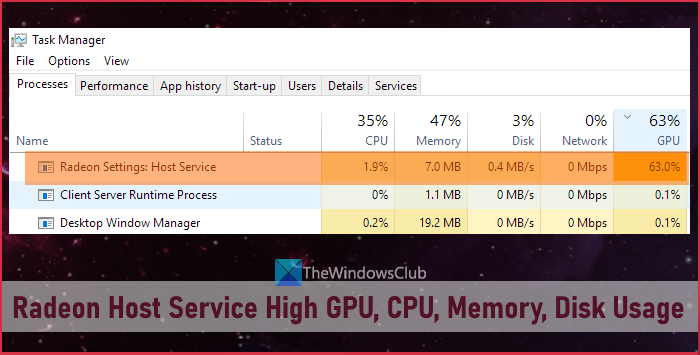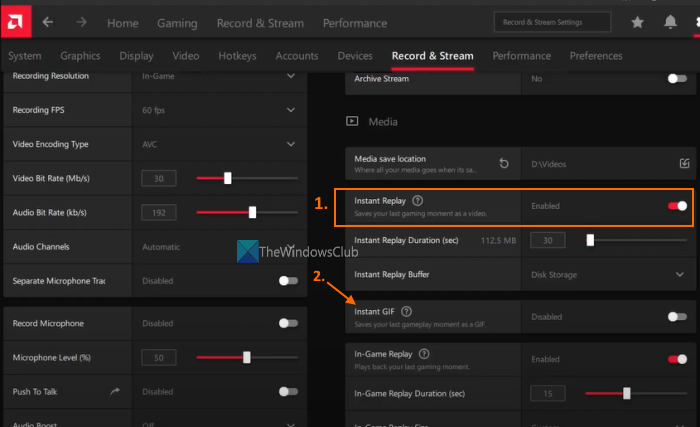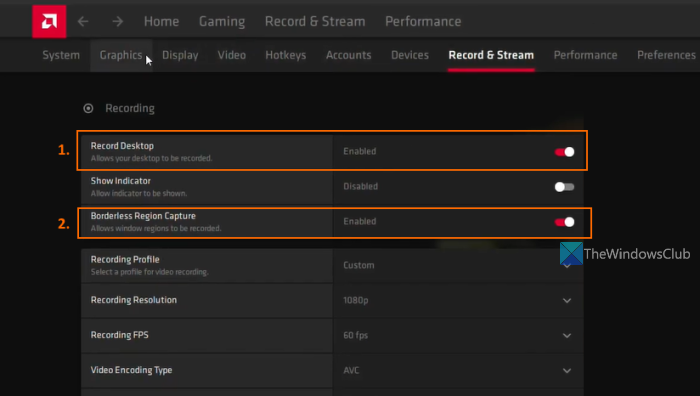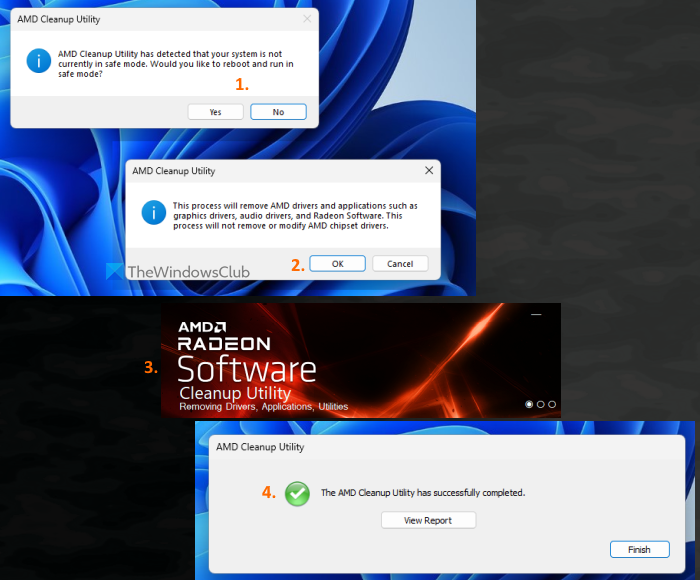This post helps to fix Radeon Host Service High GPU, CPU, Memory, and Disk Usage problem on a Windows computer. Some users have complained that when the Radeon Settings: Host Service (AMDRSServ.exe), a component of AMD Radeon Software, is running on their Windows 11/10 PC, it consumes more than 60% of GPU and CPU usage, while the Memory or RAM usage goes beyond 50% or 80%, and disk usage is occupied to 100% sometimes. We have included some handy solutions to fix this issue.

Before proceeding, you should update your AMD Radeon software and see if it helps. If you are using AMD Radeon Software 2019 edition, update it to the latest AMD Radeon Software Adrenalin Edition (23.1.1). If the latest version is not compatible with your graphics card, then you can download the compatible software for your graphics card from the official website and use it.
Fix Radeon Host Service High GPU, CPU, Memory, Disk Usage
To fix the Radeon Host Service high GPU, CPU, memory, and disk usage issue on Windows 11/10, use the fixes added below:
- Disable Instant Replay
- Turn off the Record Desktop feature
- Terminate the AMDRSServ.exe process
- Use AMD Cleanup Utility.
1] Disable Instant Replay

This solution has helped some users and it may work for you also. Instant Replay is a built-in feature of AMD Radeon software which if enabled lets you record the last gaming moments (up to 20 minutes max) as a video. Though the feature is surely good, if you don’t use it, it unnecessarily eats up GPU and the system resources. This could be the reason that you face high GPU, memory, CPU, or disk usage problem while Radeon Settings Host Service is running. So, you need to disable the Instant Replay feature. Here are the steps:
- Open the interface of AMD Radeon Software (latest version Adrenalin Edition)
- Click the Settings icon (or cogwheel) available on the top-right part
- Access the Record & Stream menu
- In the Media section, use the Disabled button available for the Instant Replay option.
You should also turn off the Instant GIF option if it is enabled. Later, whenever you want to use these features, enable them using the above steps.
2] Turn off the Record Desktop feature

This is one of the effective solutions to fix this Radeon Host Service high GPU, CPU, memory, or disk usage problem. AMD Radeon Software Adrenalin Edition comes with a Recording feature (previously called ReLive) that lets you record your gameplay. But, if you are not using this feature for the time being, then you should turn off the Record Desktop feature present in the Recording section. Some users saw a significant improvement in GPU usage, memory usage, etc., after turning it off. Here are the steps:
- Right-click on your Windows 11/10 desktop
- Select the AMD Radeon Software option to open the Settings window
- Press the Settings icon present in the top-right section
- Select the Record & Stream menu
- Now under the Recording section, turn off the Record Desktop option to disable it using the given button
- In addition, you should also turn off the Borderless Region Capture option.
Also, turn off Live Stream (if configured) for any of the connected accounts (Twitch, YouTube, Facebook, etc.).
In case you need to record your game later, you can enable the same feature and then use the associated hotkeys to start and stop the recording. Otherwise, keep this feature turned off when not in use to save GPU and system resources.
Related: Best AMD Radeon Settings for gaming on PC
3] Terminate the AMDRSServ.exe process
AMDRSServ.exe process is associated with AMD Radeon: Host Service. So, after terminating the AMDSServ.exe process, you may be able to see a significant drop in GPU, disk usage, RAM, or CPU usage. For this:
- Open the Task Manager
- Switch to the Details tab
- Look for exe process
- Right-click on that process, and select the End task option.
4] Use AMD Cleanup Utility

If the above solutions don’t help, then there might be a problem with the AMD Radeon Software installed on your system. In that case, you should re-install AMD Radeon software. Before doing that, it is good to use AMD Cleanup Utility. This official tool from the company helps to remove previously installed AMD audio drivers, graphics drivers, and AMD Radeon Software, that might be conflicting with the software installed on your PC.
First, uninstall the AMD Radeon Software from your computer. Now grab this tool from amd.com. Run the downloaded application file of this tool and it will prompt you to reboot in safe mode. You can press the No button to continue the clean-up process in the normal mode (safe mode is recommended though). Press the OK button to begin the clean-up process. It will start removing Radeon drivers, applications, and other utilities.
Finally, use the Finish button to close the tool. You can also use the View Report button to check the list of components removed. After this, restart your Windows computer.
Now download the AMD Radeon Software from the official website compatible with your graphics card and install it. This should solve your problem.
Can I disable the Radeon software startup task?
If you don’t want AMD Radeon Software to run automatically when Windows starts, then you can disable it from the Startup programs list. For this, open the Settings app (Win+I) of Windows 11/10, access the Apps category, and open the Startup page. Look for AMD Radeon Software and use the toggle to turn it off.
Is it OK to delete Radeon software?
If you face any trouble with the installed version of AMD Radeon Software like you’re having trouble while recording the games, the In-Game Overlay menu is not appearing, AMD Radeon Software is not opening at all, and all the possible fixes don’t work for you, then you should delete or uninstall AMD Radeon Software from your system. Also, make sure all its leftovers and other data are removed completely before installing it again.
Read next: How to disable the Radeon Software Press Alt+R to open Overlay.